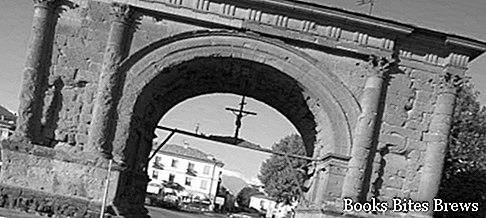What to see in Aosta, one-day itinerary including the main monuments and places of interest, including Porta Pretoria, Arco di Augusto, Roman Theater, Collegiata di Sant’Orso, Cathedral of Santa Maria Assunta and Archaeological Museum.
Tourist information
Capital of the Aosta Valley, Aosta is located at 583 meters above sea level, in a valley surrounded by magnificent mountains near the confluence of the Buthier and Doria rivers, at the point of convergence of the roads that descend from the Grande and Piccolo San Bernardo.
Founded by the Romans around 25 BC, with the name of Augusta Praetoria, at the beginning of the Augustan era it was a garrison created with the aim of defending the paths that led to the countries beyond the Alps.
The Roman footprint is still clearly visible in the urban structure, in the monuments of the city and in the imposing defensive walls, adapted and subsequently transformed during the medieval era.
Going along the perimeter of the walls starting from the Porta Praetoria, which constituted the main access to the Roman city, you will find the Tour Fromage, dating back to the Middle Ages, the Torre dei Balivi, also from the Middle Ages and built on the structures of the pre-existing Roman tower, the Torre del Lebbroso, transformed into a feudal residence by the noble Friour, the Torre di Bramafam and the Torre Pailleron, to return again to the Porta Praetoria.
The Arch of Augustus is considered the symbol of the city of Aosta, built in 25 BC on the occasion of the foundation of the city and following the victory of the Romans over the Salassi, who were the people who had inhabited this territory until then.
The arch is located near the remains of the Roman bridge, along the road leading to Porta Praetoria.
Under the vault of the arch there is a copy of a fifteenth-century wooden Crucifix, which had been placed there as a votive offer against the frequent flooding of the nearby Buthier stream, the original Crucifix is kept in the Treasure Museum included in the complex of the Cathedral of Aosta.
After passing Porta Praetoria, flanked by the twelfth-century Tour de la Trinité, a street leads to the Archaeological Park of the Roman Theater, where you can admire the ruins of the prestigious monument, of which a part of the high wall of the facade remains, having more orders of windows, in addition to the lower part of the auditorium and the scene.
What see
Near the remains of the theater, in the courtyard of the convent of S. Caterina, dating back to the thirteenth century and built on the ruins of the amphitheater, there are the remains of the amphitheater from the first century AD.
In Piazza Giovanni XXIII stands the Cathedral, dedicated to Santa Maria Assunta, which boasts very ancient origins dating back to the end of the fourth century, when it was built near the ancient Roman forensic complex, at the beginning of the spread of Christianity.
Recommended readings- Aosta Valley: 1-day Sunday trips
- Valle di Cogne: what to see
- Bard (Aosta Valley): what to see
- Gran Paradiso (Aosta Valley): excursions in the national park
- Aosta (Aosta Valley): what to see
The Cathedral, which was completely rebuilt during the eleventh century with subsequent interventions, has a neoclassical facade, while the interior is in Renaissance style.
The building preserves one of the main testimonies of the pictorial and figurative culture of the years around the year 1000, called the Ottonian because it flourished during the reigns of the emperors of the house of Saxony, when the progenitor Otto I reigned from which it derived its name.
Another example of the Ottonian style is present in Aosta in the monumental complex of the Collegiata di Sant’Orso, composed of the Collegiate, dedicated to Saints Peter and Bear, dating back to the fifth century but rebuilt around the eleventh century.
On the left side of the Cathedral, going down a staircase you reach the complex of the Forensic Cryptoporticus, a Roman monument that surrounded the sacred area of the ancient city forum.
The complex consists of a double corridor with barrel vaults, supported by massive pillars in tuff blocks that create a very suggestive environment.
The Regional Archaeological Museum-Mar preserves important evidence of the presence of man in the Aosta Valley, from Prehistory to the Middle Ages.
The museum is housed in a building located in the place where the Porta Principalis Sinistra was located in Roman times, the remains of the door are visible in the basement.




